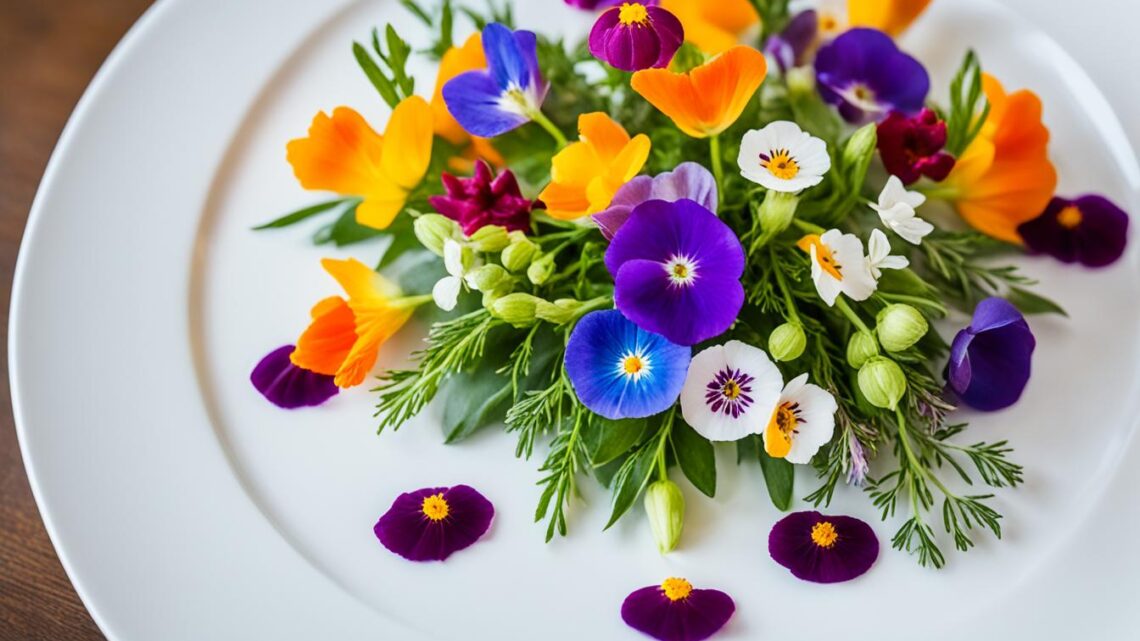
Have you thought about adding colorful and tasty edible flowers to your food? These flowers edible come in many colors, shapes, and flavors. They can make your meals and drinks more exciting. From sweet to savory, edible blooms open up new possibilities for cooks and mixologists.
But what are edible flowers list? How can you use their nutritional and beauty benefits? Let’s explore the magical world of flowering plants for eating. We’ll see how culinary flowers can make your meals special.
Introduction to Edible Flowers
A new trend is growing in the culinary world – edible flowers. These flowers are not just for decoration. They are now a key part of many meals around the world. But what are edible flowers, and how do they help our diets?
What are Edible Flowers?
Edible flowers are flowers that you can eat. They can be used in many ways, like as garnishes, in salads, or in desserts. These flowers make your food look beautiful and are good for you too.
Benefits of Incorporating Edible Flowers into Your Diet
Many edible flowers are full of antioxidants, vitamins, and minerals. Adding them to your meals makes your diet healthier. They also bring unique tastes and textures to your food, from sweet to savory.
Studies show that edible flowers are getting more popular. More people love their bright colors and different flavors. Now, you can even buy edible flower mixes in stores.
If you’re a chef or just like cooking at home, edible flowers can change your cooking. They add elegance and new flavors to your dishes. Edible flowers are a great way to make your meals more interesting and healthy.
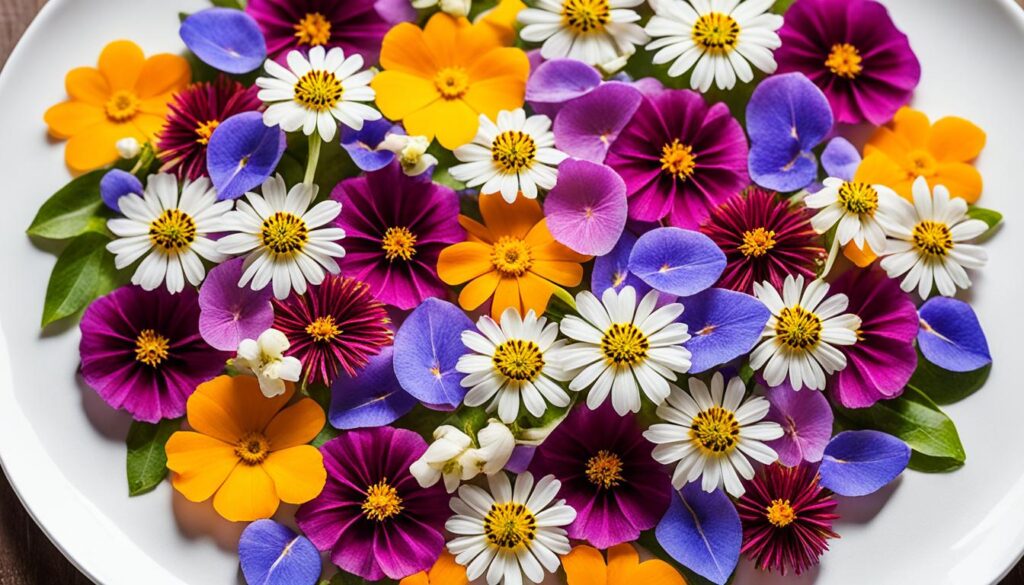
Common Edible Flowers
Chamomile and pansies are two popular edible flowers. They add beauty and unique flavors to dishes. This makes them great for cooking.
Chamomile: Crisp and Mildly Sweet
Chamomile flowers, also known as English daisies, have a special smell and taste. They are crisp and a bit sweet. You can use them in both sweet and savory dishes.
Chamomile is easy to grow and does well in many soils. It’s a great choice for anyone who loves to garden.
Pansies: Delicate Flavor with a Peppery Finish
Pansies and violas have a light taste with a hint of pepper. They’re perfect for decorating salads, desserts, and cocktails. Their bright colors add fun to your food.
Pansies are simple to grow and spread on their own. They’re a great choice for anyone who wants to grow their own food.
You can find chamomile and pansy flowers at farmers’ markets or special stores. Or, you can grow them in your garden. They add unique tastes and beauty to your cooking.
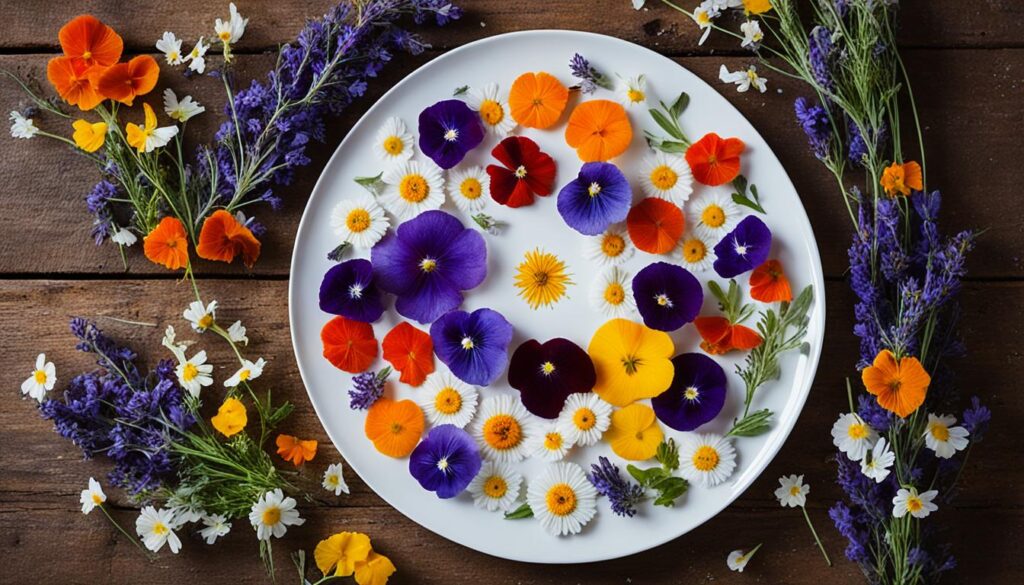
Cosmos: Delicate Garnish for Special Occasions
Cosmos flowers are perfect for special events like weddings or baby showers. They are mild in taste, similar to lettuce. Cosmos edible flowers add elegance and visual appeal to your dishes without overpowering other flavors.
Edible flowers for garnish last about 5 days and are in season from June to August. They cost £4.19, making them a great way to impress your guests without spending a lot.
| Characteristic | Details |
|---|---|
| Shelf Life | 5 days |
| Price | £4.19 |
| Seasonal Availability | June-August |
| Free Delivery | On orders over £250 |
| Allergens | No Allergens Recognised |
| Blooms per Package | 8-10 |
| Delivery Options |
|
| Contact |
01362 760760 info@nurturedinnorfolk.co.uk |
Looking to garnish a cocktail or add elegance to a dessert? Cosmos edible flowers are a great choice. They have a mild flavor, letting other ingredients take center stage. They’re perfect for any special occasion.
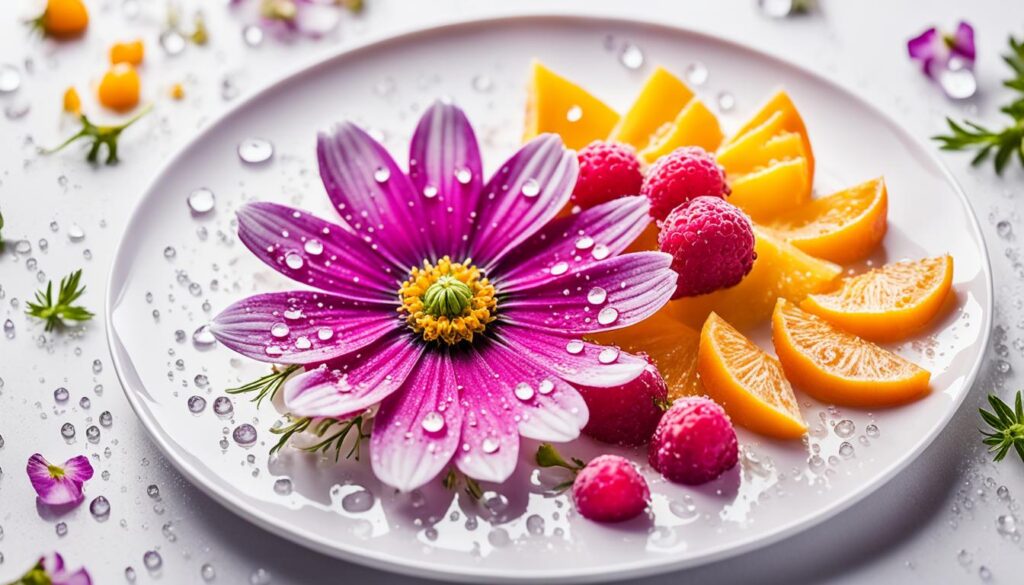
flowers edible: A Colorful and Nutritious Addition
Edible flowers add color and nutrition to meals and drinks. They are full of antioxidants, vitamins, and minerals. This makes them a great choice for a healthy diet. From the bright colors of marigolds to the soft taste of pansies, they make food look and taste better.
Hibiscus may help lower blood pressure and cholesterol, but more studies are needed. Dandelions have antioxidants that are good for health. Lavender is calming and can be added to many foods, like baked goods and teas.
Honeysuckle is used in Chinese medicine and makes a tasty tea or syrup. Nasturtium is full of minerals and antioxidants, which are good for you. Borage treats minor health issues and tastes like cucumber and honey.
| Edible Flower | Nutritional Benefits | Culinary Applications |
|---|---|---|
| Purslane | Rich in omega-3s, more than almost any other vegetable | Can be served cooked or raw in salads, sandwiches, or as a side dish |
| Rose Petals | Potential health benefits like reducing anxiety and promoting relaxation | Can be added to a range of dishes, offering a floral and slightly sweet flavor |
| Squash Blossoms | Edible parts of various summer squash plants, including zucchini | Can be incorporated into a variety of culinary dishes |
Edible flowers are colorful, tasty, and good for you. They can make any eating edible flowers menu or drink special. Try adding edible flowers nutrition to your cooking and see how they can improve your dishes.
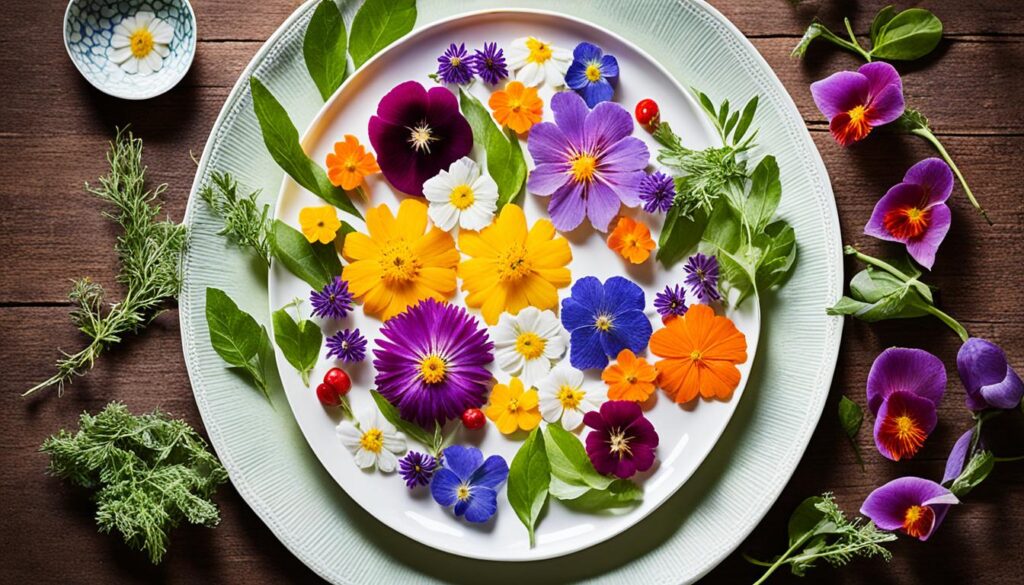
Flowering Herbs: Flavorful Blooms from Your Garden
Many common herbs like basil, dill, and thyme produce edible flowers. These flowering herbs edible add delicious flavors and bright colors to your food. They make your dishes more tasty and pretty.
Basil Flowers: Intense Herbal Aroma
The blossoms of basil have a strong intense herbal aroma like the leaves. You can put basil flowers on salads or pasta. They also work well in oils and vinegars, adding flavor to your food.
Dill and Thyme Blossoms: Subtle Flavors
Dill flowers and thyme blossoms have soft tastes, a bit sweet and a bit bitter. Use them to make soups or cocktails look and taste great. They add a nice touch to your dishes.
| Herb | Flavor Profile | Culinary Uses |
|---|---|---|
| Basil | Intense herbal aroma | Salads, pasta dishes, oils, vinegars |
| Dill | Subtle, slightly bitter and sweet | Soups, sauces, cocktails |
| Thyme | Subtle, slightly bitter and sweet | Soups, sauces, cocktails |
Adding these flowering herbs edible to your cooking makes your dishes more flavorful and pretty. It takes your cooking to the next level.
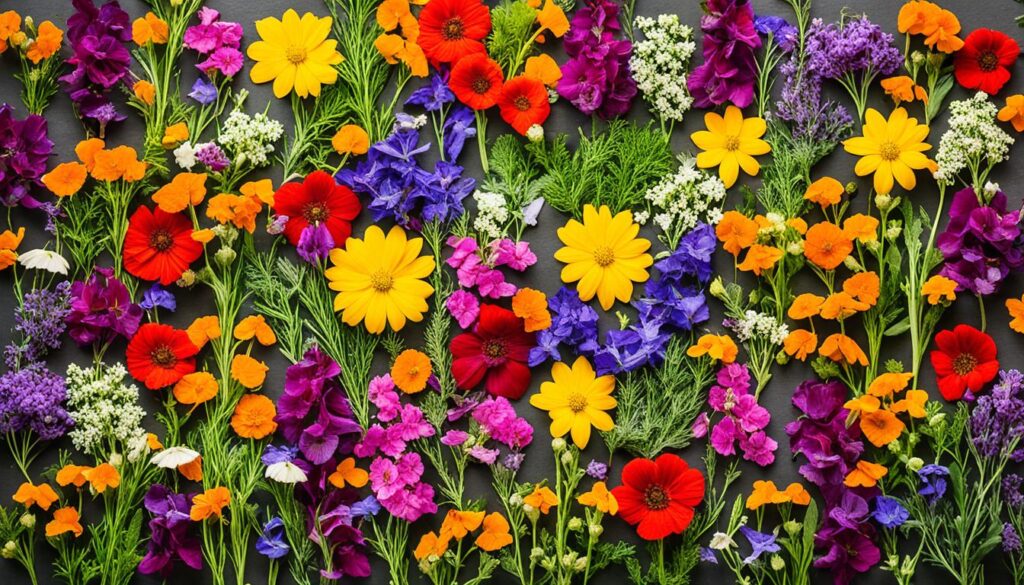
Microgreens and Edible Flowers: A Perfect Pairing
Microgreens and edible flowers make a great team in the kitchen. They add color, texture, and taste to your dishes. This combo is perfect for making your food look and taste amazing.
Microgreens are young, packed with nutrients. They’re great for holding up the delicate flowers. The Micro Celebration Mix includes micro radish, micro arugula, and micro basil. It also has edible flowers. This mix makes your food look and taste great.
Microgreens are full of vitamins and minerals. A small serving has about 10-15 calories. It also has 2-3 grams of carbs, 1-2 grams of protein, and 1-2 grams of fiber. They’re full of vitamins A, C, and K, iron, magnesium, and antioxidants.
When you mix microgreens with edible flowers, you get a mix of flavors and textures. Flowers like violets, roses, and mallows have been used in cooking since ancient Rome. But not all flowers are safe to eat, so be careful.
Edible flowers add elegance to your dishes and unique flavors. Calendula tastes a bit like pepper and is great in savory dishes. Lavender adds a special aroma to drinks and desserts. Nasturtium tastes like watercress and can be used in many ways.
When adding edible flowers to your food, start with a little to see if you’re allergic. Pick flowers in the morning, clean them well, and remove the pistils and stamens. You can freeze or candy them to keep them fresh and tasty.
The Micro Celebration Mix and edible flowers are a great team for food lovers. They let you create amazing dishes that look and taste great. With care and creativity, you can impress your guests and delight their senses.
| Ingredient | Flavor Profile | Culinary Uses |
|---|---|---|
| Microgreens | Nutrient-dense, often more flavorful than mature greens | Salads, garnishes, sandwiches, soups, and more |
| Calendula | Slightly peppery, tangy | Savory dishes, oils, and vinegars |
| Lavender | Aromatic and floral | Teas, cocktails, baked goods, and desserts |
| Nasturtium | Peppery, similar to watercress or arugula | Salads, sandwiches, and as a garnish |

Vibrant Edible Amaranth: A Striking Garnish
Looking to make your dishes stand out? Try edible amaranth flowers. These flowers, also known as «Firestix,» make any dish look amazing. They’re perfect for large platters or grazing tables.
The amaranth flowers come in bright colors like deep crimson and vivid gold. They taste a bit bitter and are dense. But they’re not meant to be eaten. Instead, use them as a garnish to add color to your dishes.
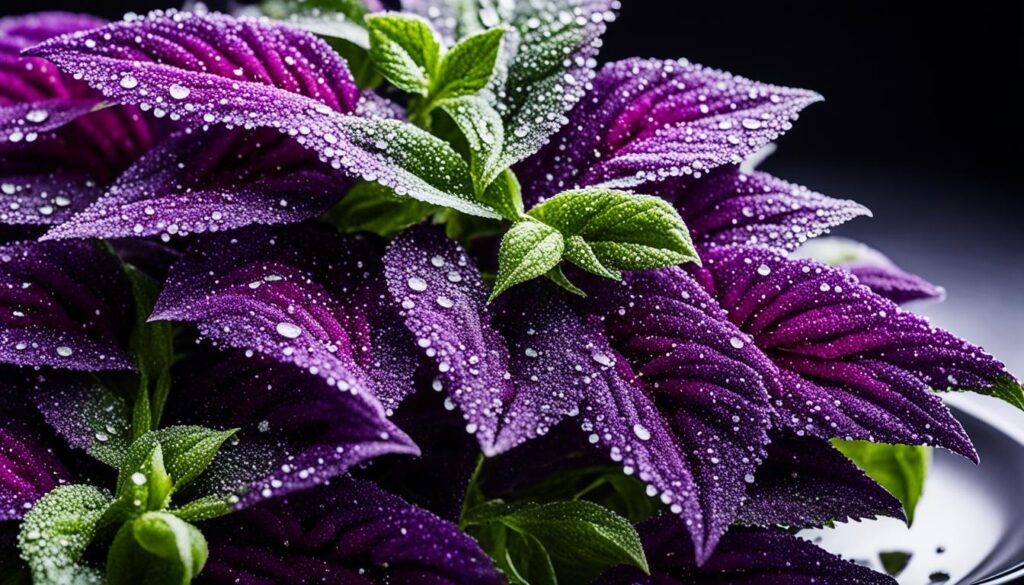
Edible amaranth flowers are very versatile. They can make your charcuterie boards, salads, or entrees look stunning. These flowers grab your guests’ attention and make your food look special.
When using amaranth flowers as garnish, make sure to get them from trusted sources. This ensures they’re safe and of good quality. With a bit of creativity, these flowers can turn your dishes into edible art.
Cornflowers: A Versatile and Colorful Addition
Cornflowers, also known as Bachelor’s Buttons, are a great addition to your cooking. They come in bright pink, blue, and maroon colors. These flowers are perfect for making summer dishes look beautiful or adding romance to a date night.
But they’re not just for looks. Cornflowers have a special flavor that can make many dishes better. They add a unique taste that goes well with many foods.
Flavor Profile of Cornflowers
Cornflowers edible have a mild taste with a hint of bitterness. This lets them work well with many ingredients. They don’t take over the taste of other foods.
You can use cornflowers in salads, as a garnish, or even in drinks. They add color and a bit of flavor. Their taste goes well with many foods, making them a great addition to your cooking.
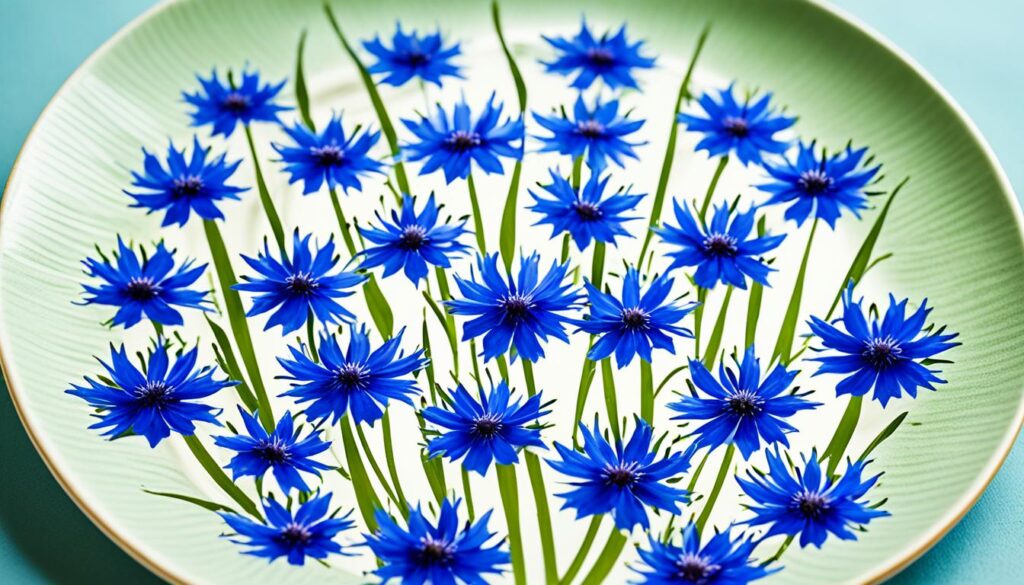
If you want to add color and new flavors to your dishes, cornflowers edible are a great pick. They’re versatile and have a unique taste. They’re perfect for anyone who loves food and wants to try new things.
Micro Marigolds: Lemony Burst of Flavor
Micro marigolds are tiny, about the size of a nickel. They are bright yellow and orange micro marigold flowers. They taste lemony and smell great. They’re perfect for small, fancy food displays.
The micro marigold flowers are tiny and always available. They have good stuff like lutein and iodine. You can keep them fresh in the fridge for 2 to 4 days. They’re great for adding flavor to many dishes.
| Flower | Flavor Profile | Culinary Use |
|---|---|---|
| Micro Marigold | Lemony, fragrant | Garnish for cheese plates, salads, and other dishes |
| Calendula (Pot Marigold) | Peppery to bitter | Adds bright color to soups and salads |
| Cornflower | Slightly spicy, clove-like with subtle sweetness | Wonderful in salads |
Using edible marigold flowers in cooking goes way back. The Mayans and Aztecs used them. Now, chefs and home cooks love them for their looks and taste.
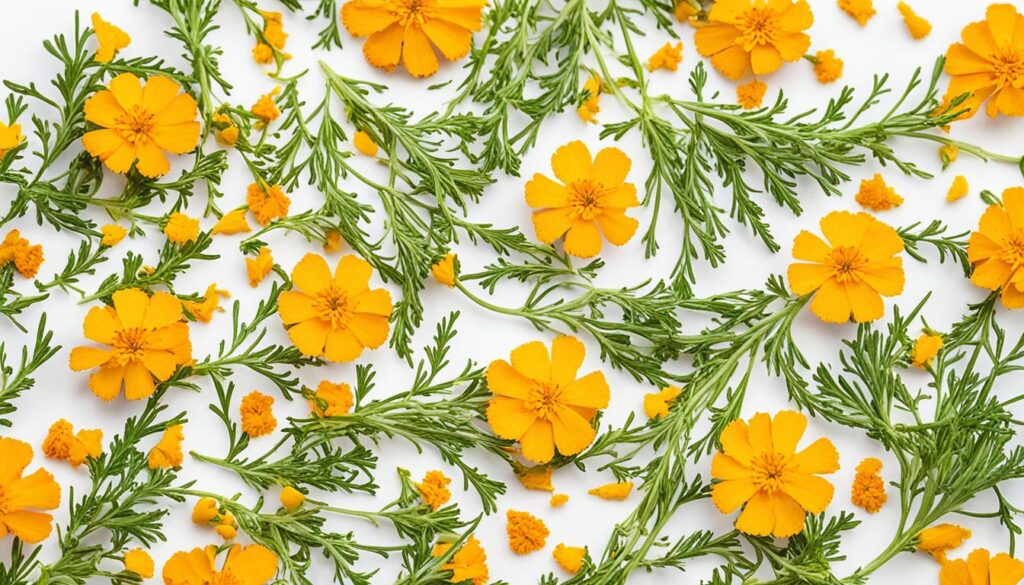
If you like gardening or cooking, try micro marigold flowers and other edible flowers. They add special flavors and beauty to your food.
Broccoli Flowers: Unexpected Delicacy
Broccoli flowers are a surprise treat with their white blooms. They taste just like the broccoli stems, adding a familiar flavor to dishes. This makes them a great garnish for simple meals.
The best temperature for broccoli flowers is between 65°F and 75°F. Plant them early in spring or late in summer, about 10 weeks before the last frost. Make sure to transplant them into the garden 4 weeks before the last frost date.
Broccoli flowers come from unopened buds that turn into small yellow flowers. If it gets too hot or if the plants don’t get enough water, they might bloom too early. But wait until the green heads start to loosen and the yellow petals show up to harvest them.
These flowers taste milder and sweeter than regular broccoli, with a hint of pepperiness. Add them to salads for a unique look and taste. Try them with broccoli florets, Greek kefalotyri, Pecorino Romano, and Parmigiano Reggiano cheeses for a tasty salad.
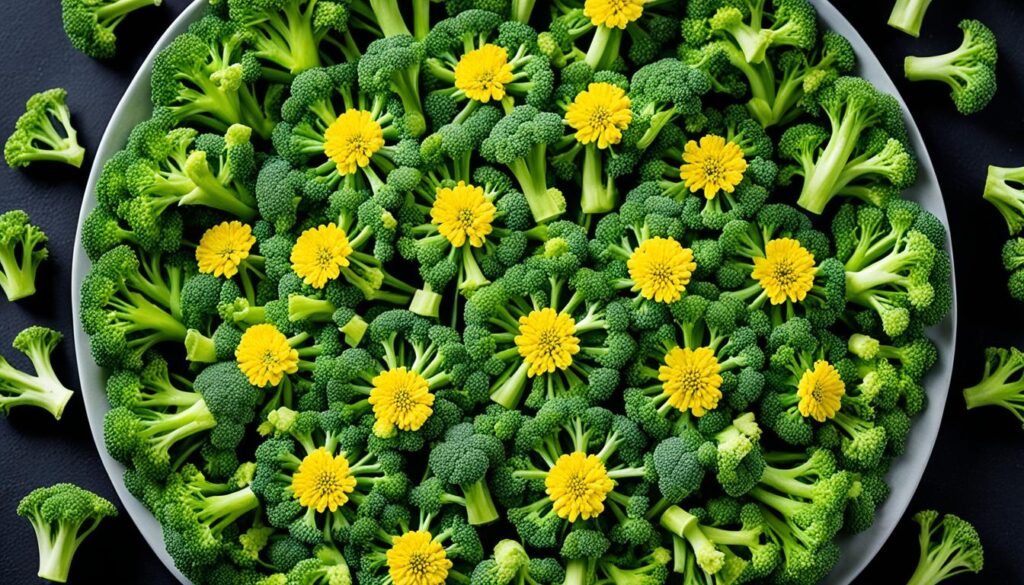
If you love gardening or cooking, trying broccoli flowers can be a new adventure. They bring unique flavors and textures to your meals. So, don’t hesitate to explore this tasty surprise.
Micro Princess: Sweet and Delicate Lavender Blooms
The Micro Princess variety of lavender is special for its small size and beauty. These tiny purple flowers are great for springtime cooking. They add elegance and a floral taste to dishes.
The micro princess lavender flowers have thin petals that melt in your mouth. They taste mildly sweet. This makes them perfect for many recipes. Use them in cheese plates or cocktails to add a special touch.
- Biscochitos, a traditional cookie from New Mexico, were made with lavender and lemon by Marla Clark.
- Lavender macarons with crumbled honeycomb and dried lavender were featured in a recipe.
- A lavender blueberry galette required at least 10 minutes to cool after baking.
- Lavender creme brulee was presented as a refreshing twist on the classic dessert.
There are over 400 types of lavender, but the Micro Princess stands out for its sweet taste. It blooms in late spring to early summer, along with other varieties like English and French lavender.
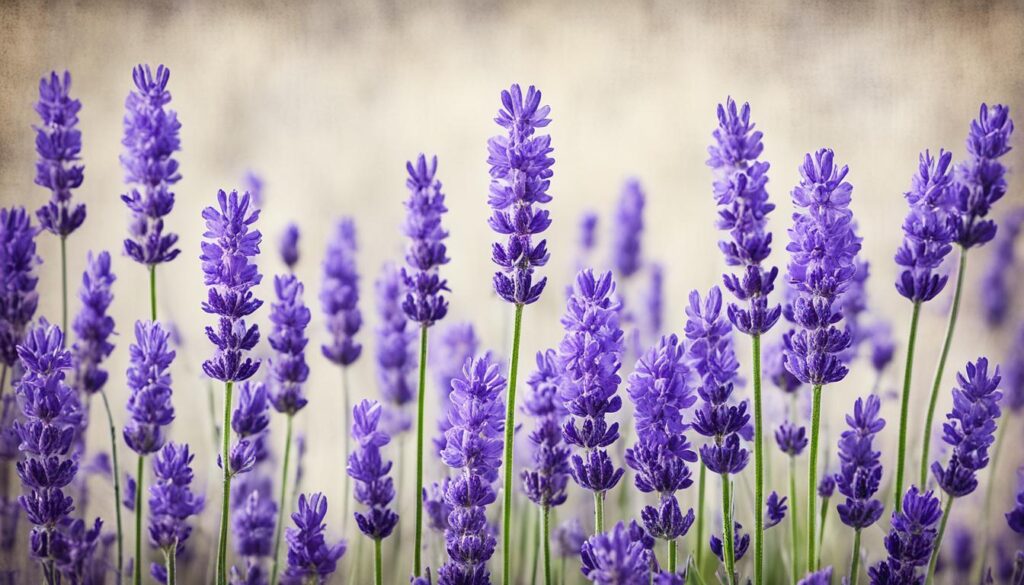
If you grow your own micro princess lavender flowers or buy them, they’re a must for cooking. They add elegance and a floral taste to dishes.
Sourcing Edible Flowers
Edible flowers can make your cooking bright and tasty. They add color, flavor, and a fancy touch. You can get these flowers in a few ways.
Growing Your Own Edible Flowers
For garden lovers, growing edible flowers is fun. Many flowers like zinnias, cosmos, marigolds, and dahlias are safe to eat. By growing them, you get fresh, chemical-free flowers for your meals.
Purchasing Edible Flowers Online
If you can’t grow your own flowers, buy them online. Online stores have many types of edible flowers. This is great for trying new flowers without a garden.
Whether you grow or buy edible flowers, it’s exciting. They can make your food look and taste better. From pretty garnishes to tasty infusions, edible flowers bring fun to your meals.
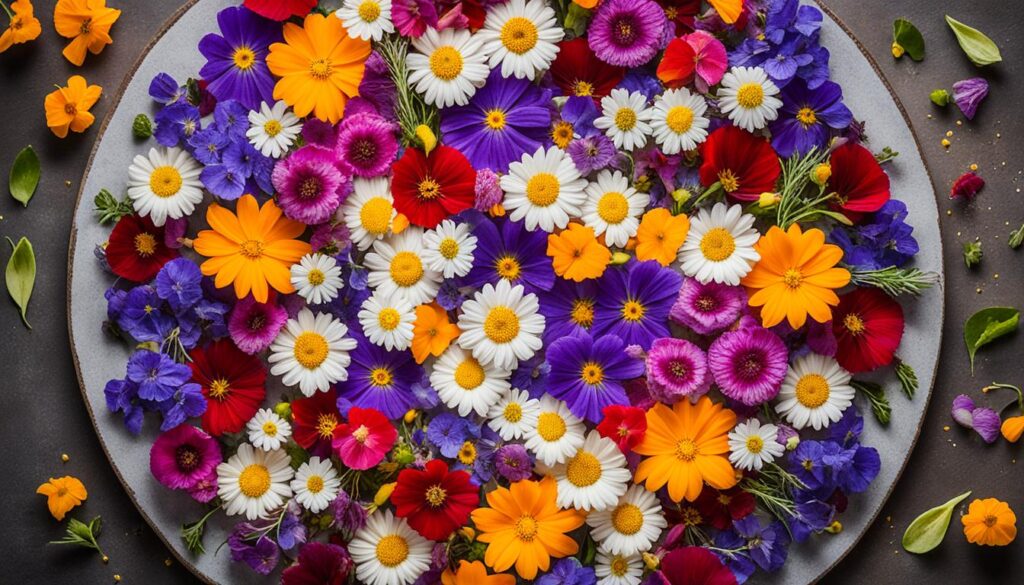
Incorporating Edible Flowers into Your Cuisine
Adding edible flowers to your cooking can make your dishes look and taste better. These flowers can turn simple meals into something special. They add beauty and flavor to your food.
Edible Flower Garnishes
Edible flowers are great for garnishing dishes. They add color and taste to salads, cheese plates, and desserts. For example, marigolds have a citrusy taste that goes well with salads.
Violas taste sweet and go well with desserts and cocktails. They make your food look and taste amazing.
Edible Flower Infusions and Cocktails
You can use edible flowers to make teas, lemonades, and cocktails. Chive blossoms add a garlic flavor to drinks. Dianthus flowers taste like cloves and are great in baked goods and drinks.
Try using marigolds to garnish a Tinto de Verano cocktail. It’s a drink from Spain that’s perfect for summer.
Using edible flowers in your cooking is a great way to make your dishes special. They add beauty and flavor. Try it and see how it can make your meals unforgettable.
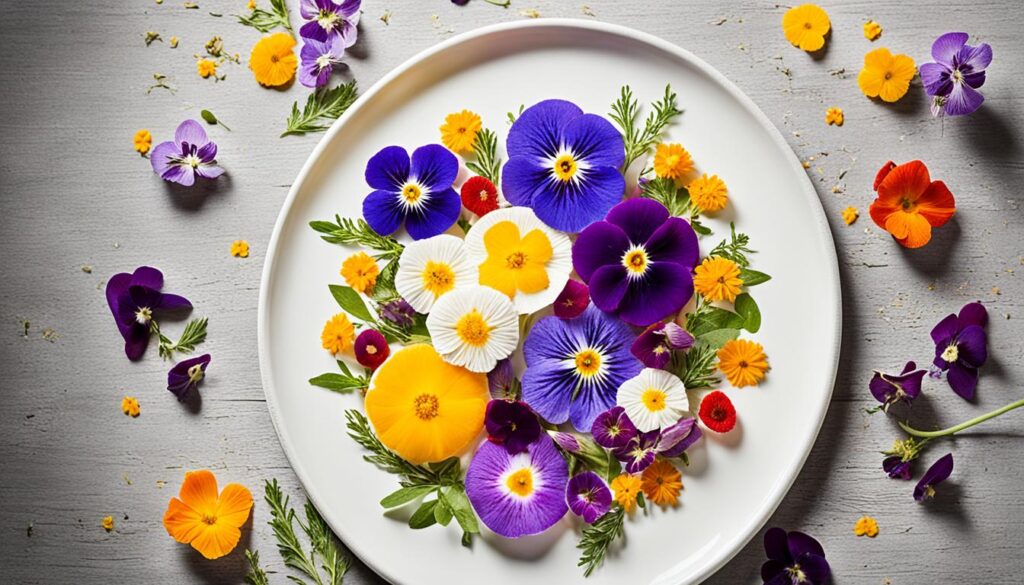
| Edible Flower | Flavor Profile | Suggested Uses |
|---|---|---|
| Fennel Flowers | Mild, licorice-like | Salads, garnishes, infusions |
| Mustard Flowers | Sharp, spicy | Savory dishes, garnishes |
| Lavender | Herbal, floral | Baked goods, cocktails, infusions |
| Chive Blossoms | Garlic, onion | Savory dishes, cocktails |
| Arugula Blossoms | Peppery, complementary to arugula | Salads, savory dishes |
Safety Considerations for Edible Flowers
Decorating your dishes with edible flowers sounds great, but be careful. Some people might have allergic reactions, especially those with pollen allergies or asthma. Always try one flower at a time and in small amounts to watch for any bad reactions.
Make sure the flowers you eat are grown without harmful chemicals. These can be dangerous if you eat them. Always get your edible flowers from trusted, organic sources. Clean and prepare them well before adding them to your food.
Before using edible flowers in your cooking, check with local food safety experts. They can tell you about any rules or safety standards. By being careful and following the right steps, you can enjoy the bright colors and special tastes of edible flowers safely.



